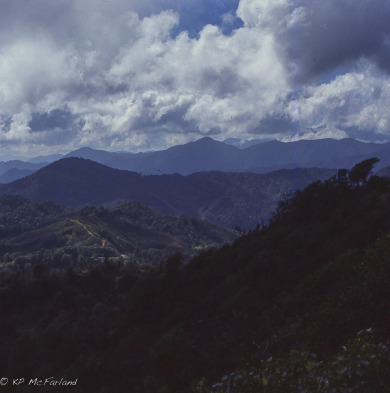Fish and other aquatic life have for decades caused the most concern among biologists and public health officials, because water harbors mercury’s most toxic form, methylmercury. But in 2005 we discovered that mercury can be transported in the atmosphere and converted to its methylated form in woodland ecosystems. After documenting the mercury threat in high-elevation forests of the northeastern United States, VCE and its team investigated forests of the Dominican Republic. From 2005 to 2011, we measured mercury levels in 365 individual birds of nine species occupying a range of sites and habitats. Every individual of all nine species showed elevated blood concentrations of mercury.
Birds in remote, mountainous cloud forests showed much higher mercury levels, on the order of two- to 20-times higher, than birds in lower-elevation rain forests. One possible explanation is that these cloud-forest sites are essentially bathed year-round in atmospheric moisture, where mercury can be more concentrated and then deposited in forests. By contrast, the researchers say, heavy rains in the lowland rain forests may rinse these sites of higher mercury levels and prevent its accumulating in the terrestrial food chain.
Birds ingest mercury through their food. So the researchers correlated mercury levels with what the birds typically ate and where in the forest they foraged. Ground-feeding species in the study showed higher mercury levels than birds gleaning food from foliage. The research team suspects that ground-dwelling spiders and other arthropods higher on the food chain accumulate more mercury than the fruits and foliage-eating insects that birds glean from mid-canopy trees.
The lone raptor in the study, Sharp-shinned Hawk, which preys on songbirds, showed the highest blood mercury level of any species. That suggests amplification of the toxin as it passes up the food web – from plant to insect to songbird and finally to the hawk – a process known as biomagnification.
Two songbird species featured in the study, Bicknell’s Thrush and Ovenbird, winter on Hispaniola and migrate to North America in spring. Blood mercury concentrations in each were higher than levels researchers typically find in either species when they are on breeding grounds in North America.
Local sources of mercury, from cement factories or smelters, may account for some of the exposure in the Dominican birds. But scientists also implicate a global reservoir of mercury, generated at industrial sources and transported in the atmosphere to distant ecosystems.
David Evers, well known for his work on mercury in wildlife but not directly involved in the Caribbean study, praised its findings. “This study as an important step in better characterizing the elevated exposure of mercury in neotropical migrants in their wintering habitats,” said Evers, executive director of Biodiversity Research Institute, based in Gorham, Maine. Evers has also discovered mercury in other North American and tropical birds.
The levels of elevated mercury found in the Caribbean are probably not killing birds outright, said Rimmer, but the toxin is known to impair reproductive performance, growth and development, motor skills, and survivorship in some birds and other wildlife. Mercury can also concentrate progressively over time in the tissues of an organism, presenting risks even if environmental levels of the toxin are low — a process known as bioaccumulation.
Coal-burning power plants are the largest human-caused source of mercury emissions in the United States. The U.S. Environmental Protection Agency estimates that one quarter of U.S. emissions from coal-burning deposit mercury within the contiguous U.S., while the remainder enters the global cycle.
VCE and other mercury experts say the findings support the need for tighter controls on mercury emissions and more research, including investigations into modes of mercury transport in the atmosphere.
PUBLICATIONS
- Townsend, J.M., C.C. Rimmer, C.T. Driscoll, K.P. McFarland, and E.E. Iñigo-Elias. 2013. Mercury concentrations in tropical resident and migrant songbirds on Hispaniola. Ecotoxicology Volume 22 (1): 86-93. DOI 10.1007/s10646-012-1005-1. (Abstract)
- Rimmer, C.C., E.K. Miller, K.P. McFarland, R.J. Taylor, and S.D. Faccio. 2009. Mercury bioaccumulation and trophic transfer in the terrestrial food web of a montane forest. Ecotoxicology 19(4): 697-709. (Abstract)
- Rimmer, C.C., K. P. McFarland, D. C. Evers, E. K. Miller, Y. Aubry, D. Busby, and R. J. Taylor. 2005. Mercury levels in Bicknell’s thrush and other insectivorous passerine birds in montane forests of the northeastern United States and Canada. Ecotoxicology 14:223-240. (Abstract)

